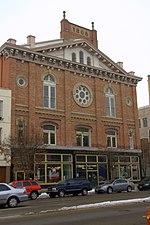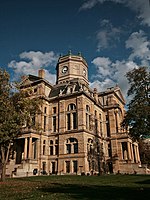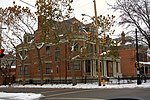Hamilton, Ohio
1791 establishments in the United StatesCities in Butler County, OhioCities in OhioHamilton, OhioPopulated places established in 1791 ... and 1 more
Use mdy dates from July 2023

Hamilton is a city in and the county seat of Butler County, Ohio, United States. Located 20 miles (32 km) north of Cincinnati, Hamilton is the second-largest city in the Greater Cincinnati area and the tenth-largest city in Ohio. The population was 63,399 at the 2020 census. Most of the city is served by the Hamilton City School District. Hamilton has three designated Historic Districts: Dayton Lane, German Village, and Rossville. The industrial city is seeking to revitalize through the arts; it declared itself the "City of Sculpture" in 2000. Its initiative has attracted many sculpture installations to the city, which founded the Pyramid Hill Sculpture Park.
Excerpt from the Wikipedia article Hamilton, Ohio (License: CC BY-SA 3.0, Authors, Images).Hamilton, Ohio
High Street, Hamilton
Geographical coordinates (GPS) Address Nearby Places Show on map
Geographical coordinates (GPS)
| Latitude | Longitude |
|---|---|
| N 39.399444444444 ° | E -84.561388888889 ° |
Address
High Street
45013 Hamilton
Ohio, United States
Open on Google Maps










